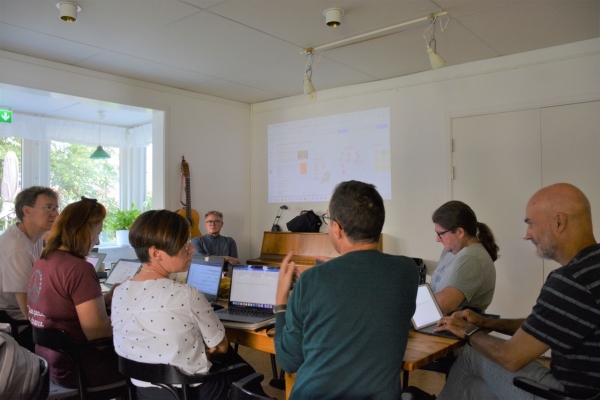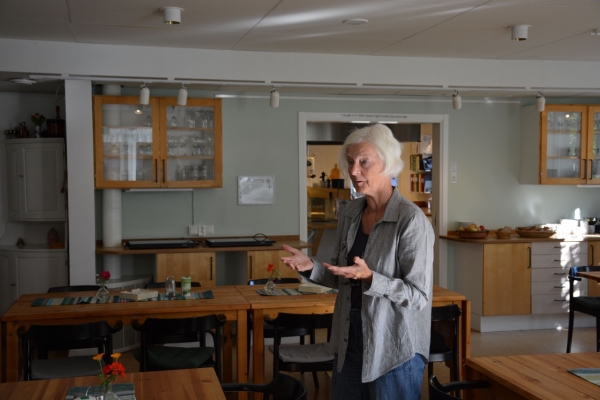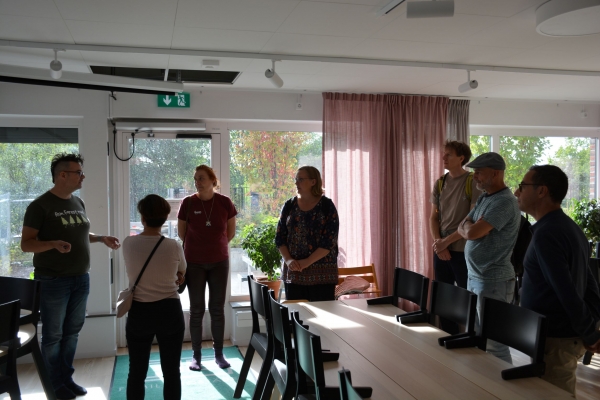CO-HOPE Meeting in Stockholm
Between the 6th and the 9th of September, the CO-HOPE (Collaborative Housing in a Pandemic Era) research team from five European countries met in Stockholm to discuss preliminary findings of the case study research. Cooperation partners as well as co-housing residents participated and we exchanged ideas with pioneers of the collaborative housing scene in Sweden. We also had the chance to visit four co-housing projects in Stockholm and get insights from residents.
At the heart of the CO-HOPE project lies the question of how residents in collaborative housing coped with the COVID-19 pandemic, with a particular focus on the intersection of housing affordability, social integration and health. The research project explores to what extent these housing settings are resilient through a combination of qualitative and quantitative research methods, such as interviews and a survey, complemented by collecting knowledge in co-creative workshops on the planning process of such housing projects.
CO-HOPE team meeting (photographer: Ruth Höpler © CO-HOPE, 2023)
Kollektivhuset Färdknäppen provided their common dining area for our team meetings as well as for transdisciplinary discussions with practice partners and co-housing residents. Kerstin Kärnekull, architect, co-housing activist (Kollektivhus NU) and resident in Kollektivhuset Färdnkäppen warmly welcomed us and introduced us to the Swedish co-housing context and her co-housing. Färdknäppen is a pioneer senior co-housing project for the“second half of life”, and follow-up projects in Stockholm have adopted their approach. It encompasses 43 apartment units (37 to 75 m²) and generous common areas on the ground floor and rooftop (approx. 400 m²). The residents are organised as an association and take care of the building maintenance, such as cleaning collective areas. A rotating cooking team consisting of residents prepares the daily common dinner.
Kerstin Kärnekull introducing us to the Swedish co-housing context and Kollektivhuset Färdknäppen (photographer: Ruth Höpler © CO-HOPE, 2023)
During our study visits, we really understood that – in contrast to Austrian co-housing – cooking and eating together are key elements in Swedish co-housing projects. Not only in older co-housings but also in the more recent Kollektivhuset Kombo, the residents planned and implemented spacious dining areas and well-equipped canteen-like kitchens, where the cooking teams prepared food. Moreover, they share the cleaning duties of the collective spaces.
The residents’ sharing practices – collective cleaning and cooking – are a vital contribution to housing affordability in a capital-oriented housing market in Sweden. Agreements between the housing companies that own the building and the residents’ association allow co-housing projects to get back the “saved” maintenance costs from the companies, which is a major income source. Minor contributions to the income are external visitors attending the collective dinner. Interestingly, non-residents commonly are members of the co-housing associations, some of whom are involved in daily activities like cooking. In Kollektivhuset Tullstugan, several residents from the neighbouring buildings of the housing complex have joined the co-housing association and are actively involved in collective activities. These external members live nearby and can come over spontaneously, so their involvement works well for the co-housing group.
Kitchen in Kollektivhuset Dunderbacken (photographer: Ruth Höpler © CO-HOPE, 2023)
Daily social interaction and collective activities can, moreover, foster social integration and positively impact the residents’ health, as highlighted in our discussions with Färdknäppen residents. The capacity of co-housing to tackle health issues not only became evident during the COVID-19 pandemic – when residents provided practical and emotional support for each other – but should be
particularly emphasised in the context of co-housing for the second half of life. In both senior co-housings visited – Färdknäppen and Dunderbacken – it became evident that these housing settings provide a caring environment for older adults, and knowing them in a healthy place can relieve their relatives. Interestingly, the majority of residents in both houses were women. According to the residents, the reason was not only a higher life expectancy but also the fact that many women in this generation are actively engaged in their second half of life.
A major challenge for Swedish co-housing remains housing affordability, particularly regarding finance and rent rates, which is somehow a precondition for other assets of co-housing. A resident of the newer co-housing project, Kollektivhuset Kombo, told us that some group members actively engaged in the planning process could not live there in the end because their monthly income was too low for the developer’s criteria. Collaborative housing groups are still struggling with the consequences of privatisation waves of the housing stock in Sweden towards the end of the 20th century and little political support.
Kollektivhuset Kombo (photographer: Ruth Höpler © CO-HOPE, 2023)
Yet, the benefits of collaborative housing not only for older adults but also for younger people are obvious, particularly in times of global crises, such as the COVID-19 pandemic. Strong communities and their social connections are key to tackling today’s challenges, and they can initiate learning processes needed for a sustainable transformation on a local scale. That is why Kerstin and other residents advocate for this housing model and try to convey these manifold benefits within and beyond the co-housing communities to politicians. This housing model can contribute to more resilient neighbourhoods and relieve the health care system through their local care networks.
Header: Chidlren’s playroom Kollektivhuset Kombo (photographer: Ruth Höpler © CO-HOPE, 2023)




